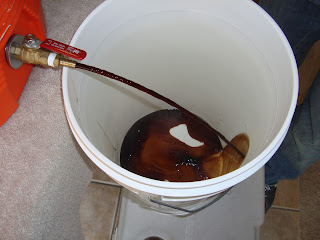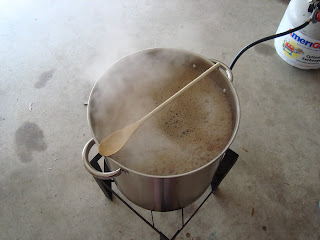My beginner’s journey of extract and partial mashing was
over and it was time to put on my big boy brewing pants and take a try at all grain
brewing. For those unfamiliar with AG (All Grain), it is a brewing process
where you extract the sugar directly from the grains (Barley, Rye, etc.). This
is different from Extract and Partial Mash because in those brewing techniques
the majority of the sugars is extracted from the grain and delivered to you
ready to boil and brew. Think of it as Hamburger Helper vs. made from scratch
pasta. There is a step up in equipment when it comes to doing AG but this was
helped by a brewing friend in McKinney who graciously let me take his Mash Tun,
but more on that later.
For my first AG beer I decided to go with a Saint Arnold’s
Lawnmower Clone. This is a Kolsch style and with spring approaching it sounded
great.
The first part of AG brewing is to extract the sugars from
the grains. This is done by letting the grains steep in hot water similar to
what happens when you make tea. For this recipe the grains needed to steep for
one hour. For that hour you need to keep them at approximately 155 degrees Fahrenheit.
The easiest way to do this is take an orange water cooler and let the grains
sit in there. This was something I didn’t have but thanks to Chris, he let me
have his.
After letting the grains steep you need to drain the mash water.
Before you can really let it flow out you have to “Vorlauf”. This lets you take
the sediment that is at the bottom of the cooler out and put them onto the top.
After draining the mash water there is still some sugars
left on the grains. To remove these you need to “wash” the grains. This is done
through a process called Sparging. I prefer to batch sparge, or dump a lot of
hot water in. After adding more hot water, vorlaufing and draining it was time
to boil.
Due to large amount of water used for AG I made the switch
to using a propane burner. Also due to large amount of water was my first
experience with a near boil over. Luckily I got the brewpot off just in time.
Don't worry, the green is from the hops
After boiling and cooling the wort, I took my gravity
reading. Unfortunately I missed the target OG by a couple of points, nothing
too crazy though. I then pitched the yeast and said goodbye to the Kolsch for a
couple of weeks.
I was fairly impressed with how simply my first AG batch
went. Several lessons were learned but overall it wasn’t too bad. Can’t wait to
try this one out!.




























